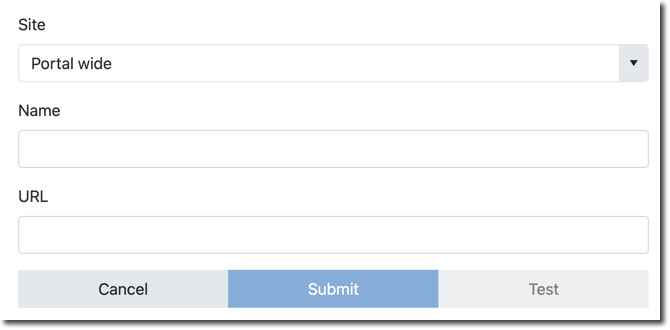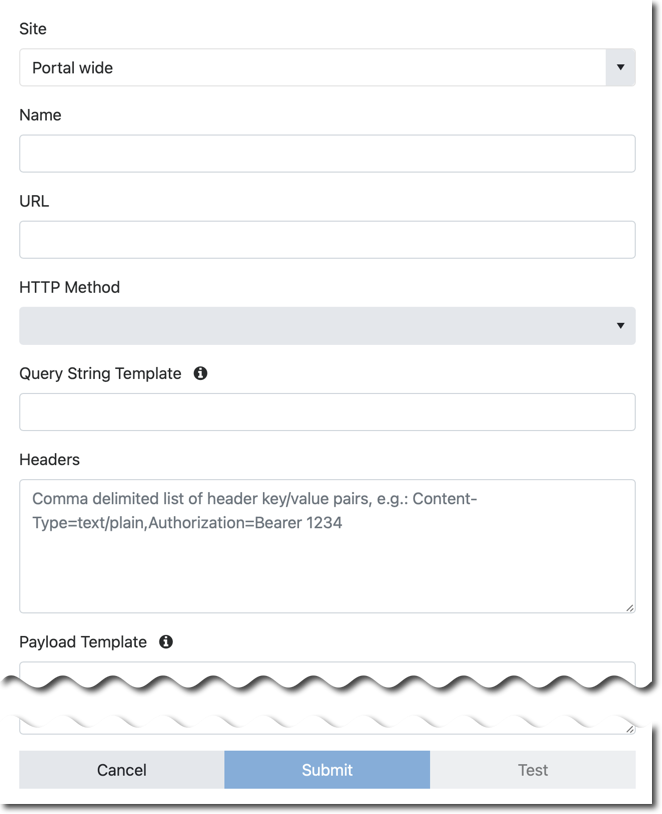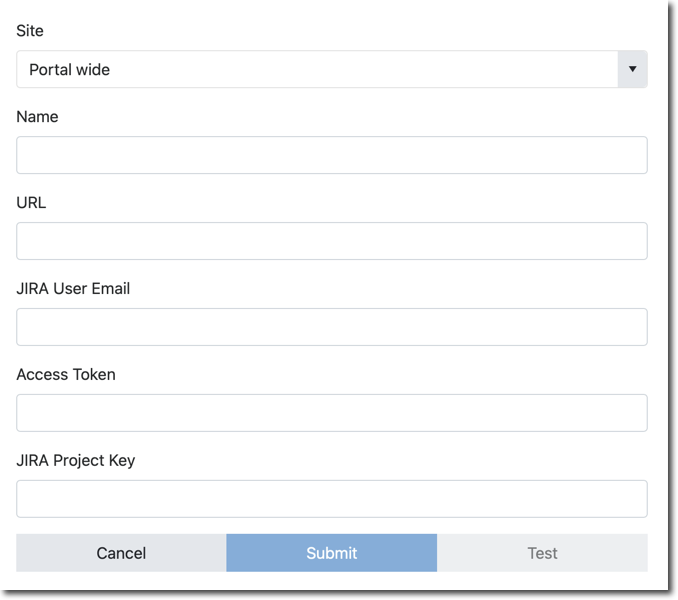Alert Responses Administration allows the administrator to edit and test alert responses which are built on top of alert response services.
What is an Alert Response Response?
An alert response tells the portal how to communicate alert events to interested recipients. A response might be sending an email or passing alert event details to Slack, JIRA, or any Webhook-enabled service your team uses.
Administrators can create one or more ways for the portal to respond to alerts from a given site, alert type, and applicable resources.
For example, they can create an email (SMTP) response and a Slack response for all page-type alerts coming from any resource of a given site. Slack and email messages will be sent when a page-type alert arrives at the portal.
This can be filtered to specific resources so you can send alert responses to different recipients based on specific resources, not just the alert type.
Here is the Alert responses admin screen:
And here are the details:
| Field | Description |
| Site | Site name as found in [PROTOPDIR]/etc/custid.cfg |
| Alert Type | See the table located at the bottom of this page |
| Resources | Select the resources this alert response applies to |
| Service | See the service table located at the bottom of this page |
| Email Recipients |
A comma-delimited list of email addresses to receive alert messages. This can include the mobile-number@carrier.xyz format. Please take a look below for more details. |
| Enabled | Whether the alert is enabled |
Create an Alert Response - Add Alert Response Button
A popup window appears when clicked, allowing the user to create an alert response record:

| Field | Description |
| Site | Site name as found in [PROTOPDIR]/etc/custid.cfg |
| Resources | Select the resources to which this alert response applies. Leave blank for "all" |
| Alert Type | See the table located at the bottom of this page |
| Notification Service | See the service table located at the bottom of this page |
| Enabled | Whether the alert is enabled |
- Select the Site this alert response is for from the drop-down.
- Select the Resources to which this alert response applies. Leave this field blank for "all".
- Select the Alert Type from the drop-down.
- Select the Alert Response Service for this Alert Response.
If you choose an SMTP-based service, you will be prompted for the (comma-separated) email address(es) to which you want to send the email. These addresses can include mobile-number@carrier.xyz. Please take a look at the carrier email address formats below.
WARNING: Lately, users of the number@carrier approach have complained of messages being received with delays exceeding an hour. Please ensure that you do not see delays before using this alert response. - Be sure the Enabled field is checked if you want this Alert Response to be used. Uncheck the box if you wish to temporarily prevent these from going out.
- Click the Submit button and the new response will appear in the list.
Mobile Number Email Address Format by Carrier - USA
NOTE: Services that are crossed out are no longer supported by the provider.
| AT&T | ###@txt.att.net |
| T-Mobile | ###@tmomail.net |
| Sprint | ###@messaging.sprintpcs.com |
| Verizon | ###@vtext.com |
| Verizon | ###@vzwpix.com |
| Virgin Mobile | ###@vmobl.com |
| Tracfone | ###@mmst5.tracfone.com |
| Ting | ###@message.ting.com |
| Boost Mobile | ###@myboostmobile.com |
| U.S.Cellular | ###@email.uscc.net |
| Metro PCS | ###@mymetropcs.com |
Mobile Number Email Address Format by Carrier - Canada
| Bell/Solo Mobility | ###@txt.bell.ca |
| Fido | ###@fido.ca |
| Chatr, Rogers,and Tbaytel | ###@pcs.rogers.com |
| Eastlink | ###@mms.eastlink.ca |
| Koodo Mobile | ###@txt.mtsmobility.com |
| PC Mobile | ###@mobiletxt.ca |
| Public Mobile | ###@msg.telus.com |
| Sasktel | ###@sms.sasktel.com |
| Telus | ###@msg.telus.com |
| Virgin Mobile | ###@vmobile.ca |
| Wind Mobile | ###@txt.windmobile.ca |
Manage Services Button
Two popup windows appear side-by-side. The left one displays defined Alert Response Services and allows the user to delete them, while the right one allows the user to create or update Alert Response Services.

Left side window:
| Field | Description |
| Type | See table located at the bottom of this page |
| Site | Site name (from [PROTOPDIR]/etc/custid.cfg) |
| Name | Alert response service name |
Dragging a column header into the space above the column headers will sort alert response records by that column in ascending order.
Right side window - the fields displayed vary depending upon the defined Alert Response Service selected on the left or the type of service selected from the Create Service dropdown: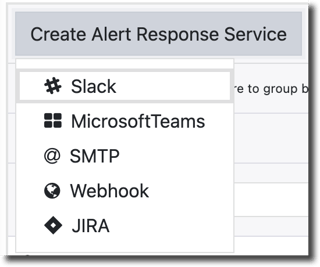
Service Type Values:
| Service Type | Description |
| Slack | Alerts are sent to the site’s configured Slack channel |
| Microsoft Teams | Alerts are sent to the configured Teams channel |
| SMTP | Alerts are sent to the email addresses listed |
| Webhook | Alerts sent to a web application |
| JIRA | Alerts sent to a Jira channel |
When "Slack" is selected as service type
| Field | Description |
| Site | Site name (from [PROTOPDIR]/etc/custid.cfg) |
| Name | Alert response service name |
| URL | Slack Channel URL/key where messages are sent |
When "Microsoft Teams" is selected as the service type:
| Field | Description |
| Site | Site name (from [PROTOPDIR]/etc/custid.cfg) |
| Name | Alert response service name |
| Microsoft Teams URL | Teams Channel URL to which alerts are sent |
When "SMTP" is selected as service type
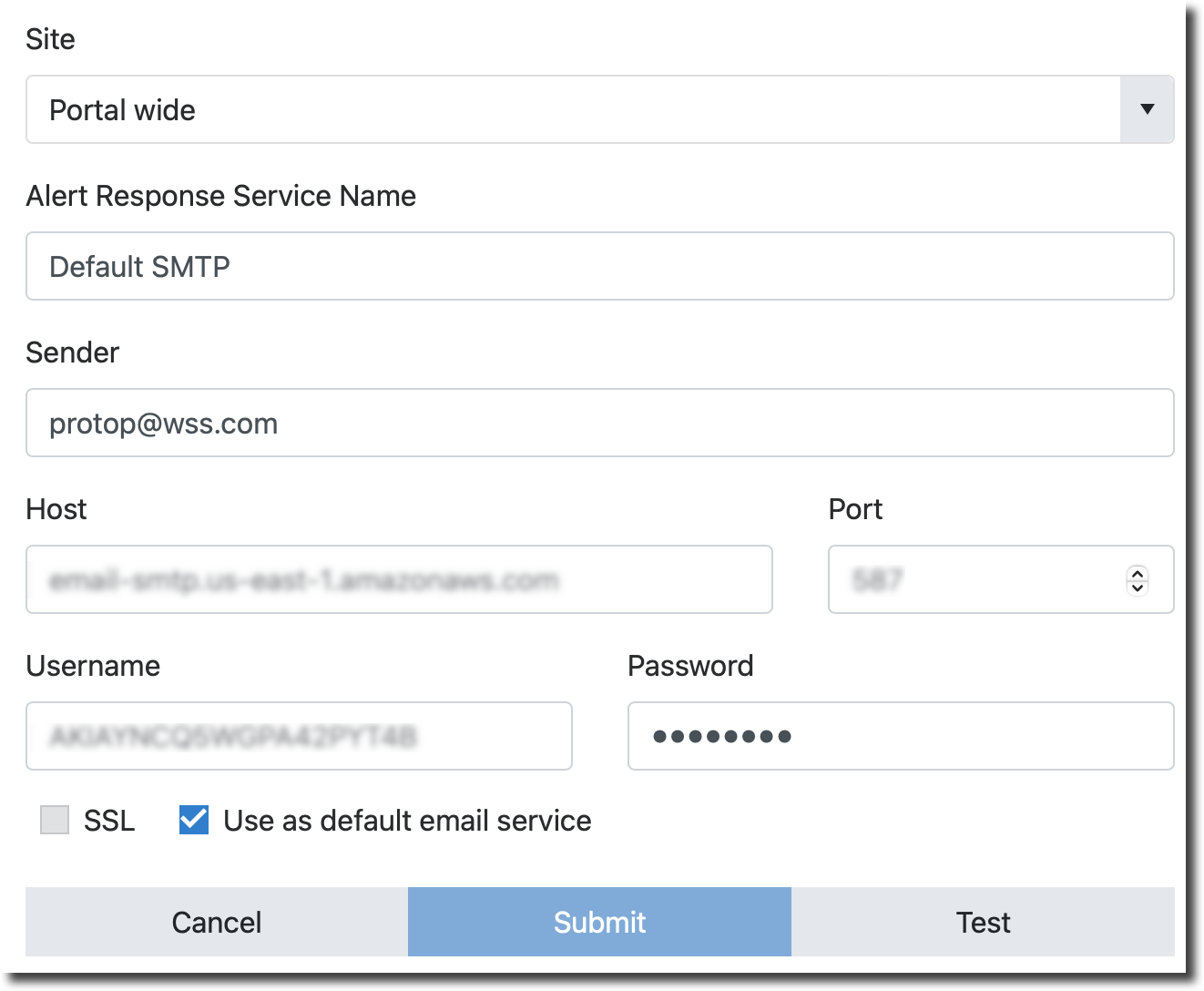
|
Field |
Description |
| Site | Site name (from [PROTOPDIR]/etc/custid.cfg) |
| Name | Alert response service name |
| Sender | Email address of the sender |
| Host | Host identifier for email target |
| Port | Port listed as the SMTP port on the target host |
| Username | Username acceptable to the target host |
| Password | The password associated with the username |
| SSL | Indicates SSL required / in use |
| Use as default email service | For automated tasks that do not use an alert response |
Note: The username and password above can be used for authentication on SMTP servers that do not require or allow other forms of authentication.
When "Webhook" is selected as the service type:
| Field | Description |
| Site | Site name (from [PROTOPDIR]/etc/custid.cfg) |
| Name | Alert response service name |
| URL | URL of the web service configured to receive alerts |
| HTTP Method | See table at bottom of this page |
| Query String Template | Defined by the web application receiving the webhook; adds values to the URL to complete the query string for delivery to the web app. (see Template Variables below) |
| Headers | Define custom HTTP headers here |
| Payload Template | Defined by the web application receiving the webhook; defines the event and data objects sent to the web app after being populated with alert details (see Template Variables below) |
NOTE: Webhook Template Variables
There are currently two template variables available for you to use in query strings and/or payloads:
- {notificationTitle} which corresponds to the subject line of the notification and
- {notificationText} which represents the notification body (note that this may contain multiple alerts)
When "JIRA" is selected as service type
| Field | Description |
| Site | Site name (from [PROTOPDIR]/etc/custid.cfg) |
| Name | Alert response service name |
| URL | The Internet address of the Jira channel is configured to receive alerts |
| JIRA User Email | The email address of the Jira user monitoring the channel |
| Access Token | Access token for JIRA user email |
| JIRA Project Key | Project key for JIRA user email |
Alert Types
| Field | Description |
| alarm | Appears in orange in the portal |
| info | Appears in blue |
| page | Appears in red |
| warning | Appears in yellow |
Webhook HTTP Methods
| Field | Description |
| Get | Standard "Get" method |
| Post | Standard "Post" method |
| Patch | User-defined method |
| Delete | User-defined method |
Service Type values
| Field | Description |
| Slack | Alerts sent to the site’s configured Slack channel |
| SMTP | Alerts sent to the emails listed when you create an Alert Response |
| Webhook | Alerts sent to a web application |
| JIRA | Alerts sent to a Jira channel |

